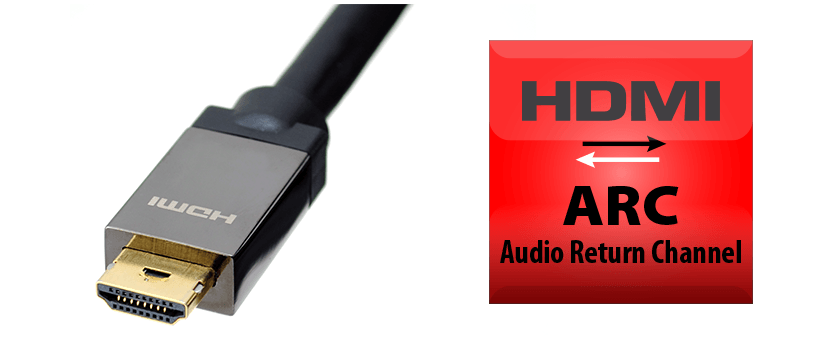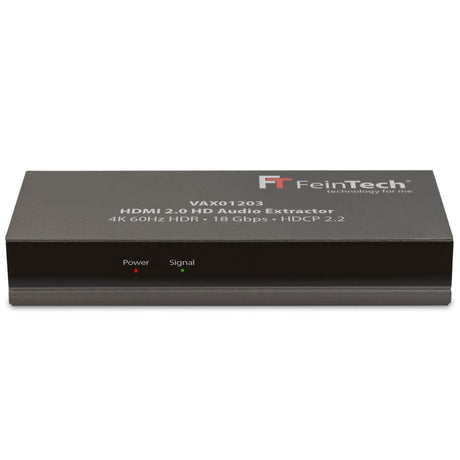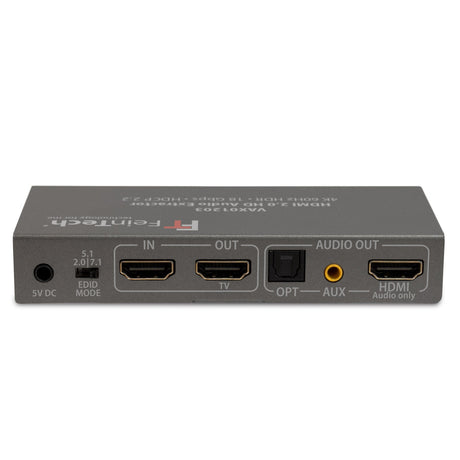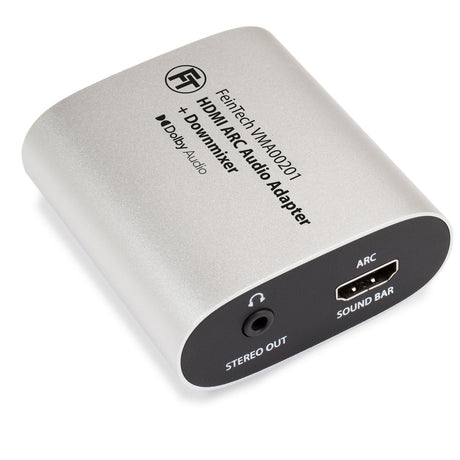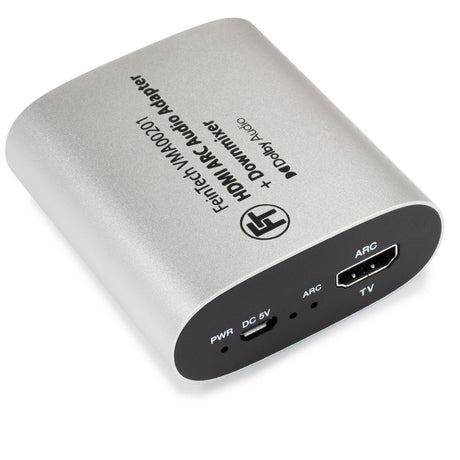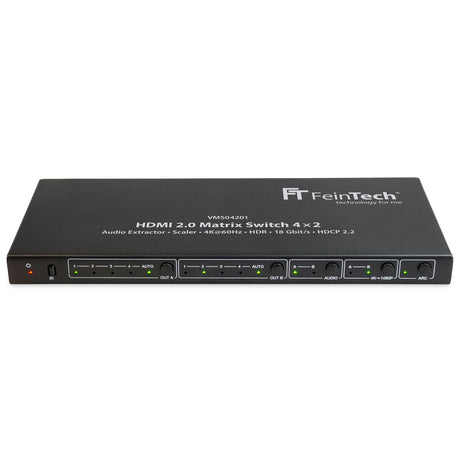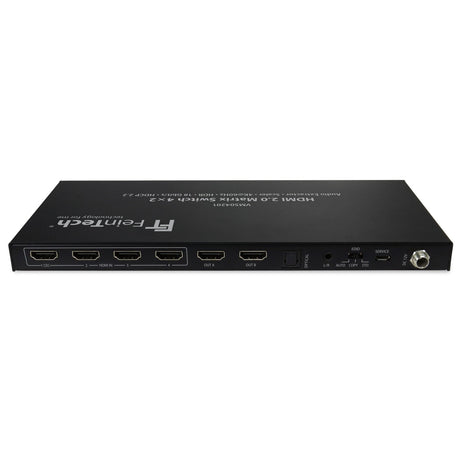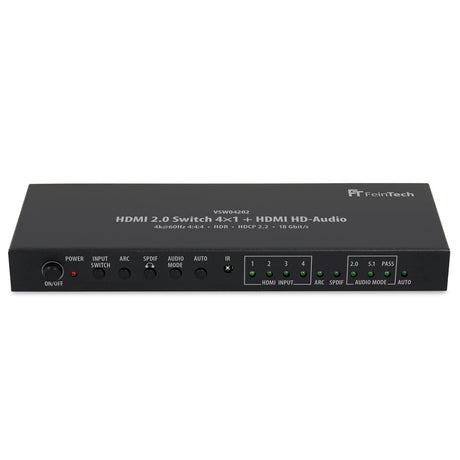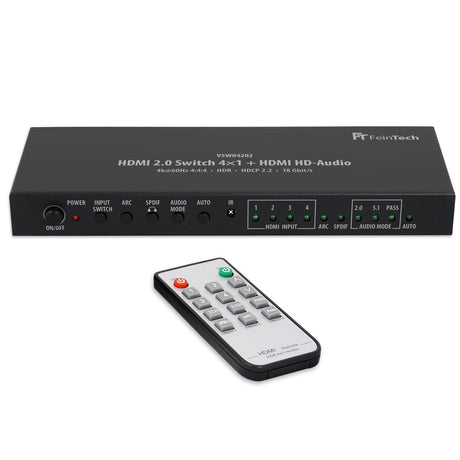Why ARC?
Many users have already noticed that the number of connections on current televisions is decreasing. Analogue connections for headphones, speakers or stereo systems are frowned upon. HDMI offers a universal solution for digital signal transport for the TV – but how do I send the TV sound to a sound system?
HDMI also offers a function here: the audio return channel has been available since HDMI 1.4. The usual setup of a home cinema system looks like this: media player > AV receiver (or soundbar) > TV. The media player delivers the picture and sound to the AV receiver, which outputs the sound and passes the signal on to the TV. The TV then basically only provides the picture. Nowadays, apps from streaming services such as Netflix, Amazon Prime, Disney, etc. play an important role. These offer 5.1 sound or even Dolby Atmos much more frequently than conventional TV broadcasts. For playback, the sound can be transmitted in the opposite direction via HDMI. The signal path is then from the TV to the AV receiver. The TV uses the same HDMI cable as in normal operation. The signal direction must therefore be switched. Usually only one of the TV HDMI sockets can do this; this is labeled ARC.

In the next step, the television must be switched to ARC output. The internal speakers are usually then switched off. The sound from the app or the internal television tuner is then output to the HDMI ARC socket and transmitted to the sound system. This then plays the sound - also in multi-channel format.
pitfalls in practice
Unfortunately, HDMI is more complicated to use than expected. Some desired configurations do not work as hoped. The device manufacturers and content providers simply do not write about what does not work. Here are a few tips from practice:
- Streaming apps like Netflix or Amazon Prime like to list the available sound formats for films and series. They often forget that only the original sound is delivered in multiple channels. The German sound is then only stereo or only 5.1 instead of Dolby Atmos.
- The media libraries of the public broadcasters also only provide stereo, although Dolby Digital is also used when receiving via satellite, antenna or cable.
- YouTube has countless surround tests & trailers – however, the YouTube app on most devices can only do stereo.
- Always connect the HDMI output (not an input) of a sound system, HDMI audio extractor or switch to the HDMI input of the TV. ARC is only the return channel for the sound, the main signal direction is reversed.
Digital audio signals do not have any volume information. It is therefore no longer possible to control the volume directly with the TV remote control. Instead, the TV transmits a control signal to the sound system via HDMI-CEC and instructs it to change the volume. This is why the ARC function is only possible on many TVs when CEC is active. (Manufacturer names for CEC are Simplink (LG), Bravia Sync (Sony), Anynet+ (Samsung), VieraLink (Panasonic), etc.
audio formats via ARC
The following formats can be transferred via ARC.
| format | Contents |
| Stereo | 2.0 (uncompressed) |
| Dolby Digital / AC3 | 2.0 or 5.1 sound |
| DTS | 2.0 or 5.1 sound |
| Dolby Digital Plus / eAC3 / DD+ | 2.0, 5.1, 7.1 sound or Dolby Atmos |
Many TVs cannot yet output DD+ via ARC. This was not part of the original specification. LG and Samsung TVs have been able to do this since around 2016. Officially, HDMI 2.1 with the eARC (enhanced Audio Return Channel) such higher audio formats (see below).
ARC when using additional HDMI components
If you have active HDMI cables or repeater they must also explicitly support the ARC! Such signal amplifiers otherwise prevent the return flow of the audio signal. HDMI splitter do not normally support ARC. This is because HDMI ARC only works with CEC communication on many televisions. A television communicates with a sound system and the sources. However, with CEC there can only be one television and one sound system, nothing more is specified. Otherwise, operating two televisions in an HDMI chain can lead to unforeseeable malfunctions.
The ARC function is also rare in an HDMI switch or matrix switch . If available, there is always a button labeled ARC to switch the signal direction. Using a HDMI audio extractors you can pick up the sound. However, note that ARC sound is almost always output digitally and therefore cannot be played on an analog stereo system. So you have to use a digital audio connection (usually digital optical).
Difference to SPDIF Digital Audio
Compared to a digital audio connection via SPDIF (Toslink or coax), HDMI ARC has the following advantages:
- Lip-sync function for automatic synchronization of image & sound
- Support for Dolby Digital Plus (with Dolby Atmos, only on newer devices)
- Control the volume via TV remote control through HDMI-CEC
At this point, however, we do not want to hide the fact that in practice, compatibility problems with the ARC are far more common than with SPDIF connections. This is due to the complex communication between the devices and the large number of possible formats.
The eARC of HDMI 2.1
The new HDMI 2.1 standard provides an extended ARC. That is why it is also called enhanced Audio Return Channel, in short eARC . This is also an audio return channel that delivers the sound in the opposite direction to the HDMI signal. The HDMI input of a television therefore delivers an eARC audio signal. This is used to output the internal TV sound (e.g. satellite TV or Smart TV app) to a sound system. When the eARC of a television is active, the internal speakers normally remain silent. But the sound of other players connected to the TV can also be passed through.
No pass-through of DTS
Sometimes there is the problem that DTS sound is not transmitted, especially with new LG and Samsung TVs. The transmission is suppressed by the TV manufacturer because it cannot be played via internal speakers due to a lack of a decoder. Sometimes it is then at least played in stereo.
DTS formats are only found on Blu-Ray disks. There are two ways to listen to such media with multi-channel sound:
1. Either output the sound already decoded (many Blu-ray players and also the Xbox or Playstation can do this). The game consoles have an additional menu for this, which only appears when a Blu-ray is inserted and allows different audio settings. If you set that DTS is not supported by the sound system, it will be output decoded as PCM5.1 or PCM7.1. This is almost lossless, only DTS-X metadata is omitted.
2. Or do not use an HDMI-eARC connection and instead transmit the sound separately. This works if the sound system has at least one "real" HDMI input. The second HDMI output of the Blu-Ray player can be connected there. If there is only a single HDMI output on the player, the signal can be distributed, e.g. with the FeinTech VAX01203 orVSW04202 .
Advantages of eARC
The eARC has more bandwidth than ARC and supports additional audio formats:
| format | Contents |
| PCM 5.1 / 7.1 | uncompressed 5.1 and 7.1 sound |
| DTS HD High Resolution Audio | compressed 5.1 or 7.1 sound** |
| DTS HD Master Audio | uncompressed 5.1 or 7.1 sound** |
| Dolby True HD | uncompressed 5.1 or 7.1 sound* |
| Dolby MAT | uncompressed 7.1 sound with Atmos |
*may contain Dolby Atmos metadata for 3D sound
**may contain DTS:X metadata for 3D sound
Do I need eARC for best sound?
No, HDMI-eARC is only required if external players are to pass HD audio formats through the TV to the connected sound system.
My TV only has one HDMI-ARC / HDMI-eARC connection. But I want to use it with two sound systems. How do I do that?
That doesn't work directly. HDMI-ARC is an addressed point-to-point connection and only one sound system is provided. The TV can't address two systems, no matter what you connect in between. The sound would also rarely be synchronized. This is probably why such a scenario was not taken into account when the HDMI standard was developed. What can you do?
- About our adapter VMA00201 A soundbar with HDMI-ARC in Dolby Digital 5.1 and headphones in stereo can be operated at the same time.
- If the sound does not come from the TV via apps or tuner, but from an external box (satellite receiver, Apple TV, Fire TV or similar), the audio signal can be distributed before it reaches the TV. A splitter such as the VAX01203 . Or a matrix switch like the VMS04201 . The sound system must have a real HDMI input in addition to HDMI-ARC.
- A few TVs can output sound via HDMI-ARC and the optical output at the same time.
- In 2024, there will be special switches such as our AX421 for the mutual operation of 2 HDMI-ARC/eARC sound devices. Normal splitters/switches are not suitable for this.

